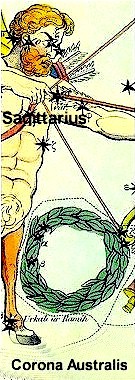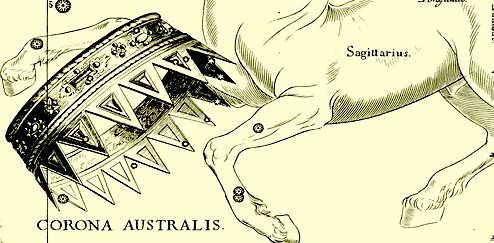Constellations of Words
Explore the etymology and symbolism of the constellations
the Southern Crown

Urania’s Mirror1825
Contents:
1. Clues to the meaning of this celestial feature
2. The fixed stars in this constellation
3. History_of_the_constellation
Clues to the meaning of this celestial feature
The Southern Crown (Corona Australis) in the southern hemisphere is a similar circle of stars to the Northern Crown, Corona Borealis, and has been sometimes called Ixion’s Wheel by earlier authors.
The stars of this constellation, Corona Australis, also represent the wreath “thrown off as by one at play” at the feet of Crotos who is identified with the constellation Sagittarius
“The constellation, Sagittarius is identified with Crotus, he had his home on Mount Helicon and took his pleasure in the company of the Musae (Muses), sometimes even following the pursuit of hunting… Before his feet are a few stars arranged in a circle, which some said were a wreath, thrown off as by one at play.” – Hyginus, Astronomica 2.27http://www.theoi.com/Georgikos/SatyrosKrotos.html
The Arabs had the title Al Kubbah, the Tortoise, for Corona Australis. The Chinese knew it as Pee, the Tortoise. Tortoise from Latin tartaruca, is related to the word Tartarus
Corona Australis also had the titles Trokhos Ixionos, and Rota Ixionis, the Wheel of Ixion
Ixion murdered his father in law when the bridal price was not forthcoming, by arranging that he should fall into a pit in which a charcoal fire was burning. Zeus apparently pardoned him and accepted him as a member of his society, upon which Ixion tried to seduce Hera and subsequently, by a phantom called Nephele (‘cloud’) substituted in her place, he fathered the Centaurs [Centaurs are the offspring of the union between Ixion and Nephele]. Enraged, Zeus, husband of Hera, punished him by having him tied forever on a revolving wheel in Tarturus.
Ixion in effect behaved like a roue, meaning “a lecherous dissipated man.” The word roue is an English translation of French roué, “from past participle of rouer, ‘to break on a wheel’ (from the feeling that such a person deserves that punishment), from Old French, from Latin rotāre, to rotate.” [American Heritage Dictionary] IxionisRota ‘Ixion’s Wheel’ is a name for this constellation and rota is related to Latin rotāre, to rotate
Ixion was chained eternally to a revolving, fiery wheel in Tartarus. A picture of Ixion on his wheel can be seen on this Greek mythology link. Ixion is compared with the wryneck bird, genus Jynx, iunx in Greek:
“There are two clues to the special nature of Ixion’swheel. Pindar says that it is ‘winged’ and that it has four spokes. A four-spoked wheel with wings upon it would have called to mind a word Pindar does not actually use in Pythian 2, the word ‘iunx‘. The wings referred to are those of a bird, the ‘iunx‘ or wryneck, whose habits in mating apparently intrigued the ancient Greeks enough to result in their use of it for magical rites designed to procure sexual satisfaction from a reluctant partner. The bird was pinned to a four-spoked wheel and the wheel was spun with appropriate incantations uttered over it, to draw the desired partner into the spell…” [Paul A. Iversen, The Ohio State University Dept. of Greek and Latin Center for Epigraphical Studies]
The wrynecks (genus Jynx) are a small but distinctive group of small Old World woodpeckers. These birds get their English name from their ability to turn their heads almost 180 degrees. When disturbed at the nest, they use this snake-like head twisting and hissing as a threat display. This odd behavior led to their use in witchcraft, hence to put a ‘jinx‘ on someone [].
“Iynx used her enchantments to charm Zeus, or make him, by magic means, fall in love with Io; in consequence of which Hera metamorphosed her into the bird called lynx (iynx torquilla)” [].
According to another story, Iynx was a daughter of Pierus, and as she and her sisters had presumed to enter into a musical contest with the Muses, she was changed into the bird Iynx. [
“Before his [Sagittarius, Crotus] feet are a few stars arranged in a circle, which some said were a wreath, thrown off as by one at play” [Hyginus, Astronomica 2.27], “or one in commemoration of the fivefold victory of Corinna over Pindar in their poetical contest” [below, Allen, Star Names].
Corona Australis was believed to be placed in the sky to commemorate the fivefold victory of Corinna over Pindar in their poetical contest. And in response to these defeats, Pindar called her a sow. Or it is the bunch of flowers that Crotus “threw off as if in play”, translated wreath. A posy is a bunch of flowers, and also a short poetic verse or sentimental inscription. Posy is related to poetry, poet, poem, from Greek poiein, to make, create. Corinna (or Korinna) was an Ancient Greek poet, traditionally attributed to the 6th century BC.
Corona Australis is also said to represent the Crown that Bacchus placed in the sky in honor of his mother Semele. Roman Bacchus who is Greek Dionysus also placed the other crown Corona Borealis, in the northern sky in honor of Ariadne. Eventually Dionysus retrieved his mother, Semele, from the underworld, named her Thyone, and placed her crown in the sky.
© Anne Wright 2008.
| Fixed stars in Corona Australis | |||||||
| Star | 1900 | 2000 | R A | Decl 1950 | Lat | Mag | Sp |
| theta | 05CAP10 | 06CAP33 | 277 28 59 | -42 21 02 | -19 03 23 | 4.69 | G5 |
| kappa | 05CAP23 | 06CAP46 | 277 29 03 | -38 45 51 | -15 28 32 | 5.95 | B8 |
| lambda | 07CAP30 | 08CAP53 | 280 05 18 | -38 22 25 | -15 12 50 | 5.13 | A0 |
| eta | 08CAP11 | 09CAP34 | 281 29 48 | -43 29 29 | -20 23 57 | 5.59 | A2 |
| epsilon | 10CAP39 | 12CAP02 | 283 50 17 | -37 10 28 | -14 16 19 | 4.87 | F0 |
| zeta | 10CAP58 | 12CAP21 | 284 53 38 | -42 10 06 | -19 19 23 | 4.85 | A0 |
| delta | 12CAP12 | 13CAP35 | 286 13 03 | -40 34 34 | -17 51 10 | 4.66 | K1 |
| gamma | 12CAP14 | 13CAP37 | 285 45 36 | -37 08 14 | -14 23 44 | 4.26 | F7 |
| beta | 12CAP41 | 14CAP04 | 286 38 53 | -39 25 20 | -16 44 45 | 4.16 | G5 |
| alpha | 12CAP45 | 14CAP08 | 286 31 06 | -37 59 04 | -15 18 22 | 4.12 | A2 |

Hevelius,Firmamentum, 1690
History of the constellation
from Star Names, 1889, Richard H. Allen
CoronaAustralis, the Southern Crown often qualified by other synonymous adjectives, austrina, meridiana, meridionalis, or notia, is an inconspicuous constellation, although accepted in Ptolemy’s time as one of the ancient forty-eight. On modern maps its location is close to the waist of Sagittarius, on the edge of the Milky Way.
. . . other few,
Below the Archer under his forefeet,
Led round in circle roll without a name.
— Brown’s Aratos
The Germans know it as the SudlicheKrone; the French, as the Couronne Australe; and the Italians, as the CoronaAustrale
Aratos did not mention it by name unless in his use of the plural Stephanoi for both of the Crowns; yet doubtless had it in mind when he wrote of the Dinotoi Kuklo in our motto. His scholiast and Geminos had Ouraniskos, the Canopy; Deuteros, the Second; and Deutera Kukla, the Second Circle. Hipparchos is said to have known it as Kerukeion, the Caduceus, or Herald’s Wand of Peace, but this is not found in his Commentary. Ptolemy called it Stephanos notios, the Southern Wreath.
Germanicus rendered the supposed reference in the Phainomena as Coronasinehonore—. without any such noteworthy tradition as is connected with the Northern Crown [Corona Borealis]; commenting upon which, Grotius said that this author, as well as Cicero and Avienus, understood Aratos to refer to the southern figure; and added that this was the Centaur’sCrown, those personages frequently being represented as wearing such. This idea doubtless originated from the outspreading sun-rays, in crown-like form, around the heads of the Gandharvas, the Aryan celestial horses that probably were the forerunners of the Centaurs. It was thus appropriately associated with the centaur Sagittarius and took the title CoronaSagittarii
{Page 173} Manilius did not allude to it; but others of the classical poets thought it the Crown that Bacchus placed in the sky in honor of his mother Semele; or one in commemoration of the fivefold victory of Corinna over Pindar in their poetical contest; and some considered it the early BunchofArrows radiating from the hand of the Archer, often imagined as a wheel. This idea was expressed in its titles Trokhos Ixionos, and RotaIxionis, the Wheel of Ixion, perhaps from the latter’s relationship to the centaur Pholos.
Albumasar called it Coelum, while Coelulum and parvumCoelum, the Little Sky, . Canopy, are from the Satyricon the encyclopaedic writings of the Carthaginian Martianus Mineus Felix Capella of the 5th century, in the 8th book of which he treats of astronomy.
La Lande cited Sertumaustrale, the Southern Garland, and OrbiculusCapitis; Proctor, Brown, and Gore of the present day have Corolla, the Little Crown, but this was used 250 years ago by Caesius, who also gave Spiraaustralis, the Southern Coil, and said that its stars represented the CrownofEternalLife promised in the NewTestament. Julius Schiller, however, went back a millennium before our era to the DiademofSolomon
Al Sufi is our authority for the Arabs’ AlKubbah, literally the Tortoise, but secondarily the Woman’s Tent, or traveling apartment, from its form; and it was Al Hiba’, the Tent, and Kazwini’s AlUdhaalNa’am, the Ostrich’s Nest, for the same reason; the birds themselves being close by in what now are the Archer and the Eagle. AlFakkah, the Dish, was borrowed from the Northern Crown, but among the later Arabians it was AlIklilalJanubiyyah, their equivalent for our title; Chilmead giving this as AlachilAlgenubi; Riccioli, ElkleilElgenubi; and Caesius, AladilAlgenubi
The Chinese knew it by the figure current in early Arabia — Pee, the Tortoise.
Bayer illustrated Corona as a typical wreath, but without the streaming ribbons of its northern namesake, and the original AlfonsineTables show a plain heart-shaped object with no semblance to the name. Gould assigns to it forty-nine stars, many more than even Heis does to its much more celebrated and noticeable counterpart in the north. Its lucida, the 4th-magnitude alpha, at the eastern edge of the constellation, is Alfeccameridiana in the Latin translation of Reduan’s Commentary. It culminates on the 13th of August.
Star Names: Their Lore and Meaning, Richard H. Allen, 1889.]